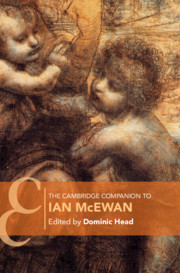Book contents
- The Cambridge Companion to Ian McEwan
- The Cambridge Companion to Ian McEwan
- Copyright page
- Contents
- Contributors
- Chronology
- Abbreviations
- Introduction
- 1 ‘Shock Lit’
- 2 Moral Dilemmas
- 3 Science and Climate Crisis
- 4 The Novel of Ideas
- 5 Cold War Fictions
- 6 The Construction of Childhood
- 7 The Public and the Private
- 8 Masculinities
- 9 The Novellas
- 10 Realist Legacies
- 11 Limited Modernism
- 12 Narrative Artifice
- Further Reading
- Index
- Cambridge Companions To…
11 - Limited Modernism
Published online by Cambridge University Press: 24 June 2019
- The Cambridge Companion to Ian McEwan
- The Cambridge Companion to Ian McEwan
- Copyright page
- Contents
- Contributors
- Chronology
- Abbreviations
- Introduction
- 1 ‘Shock Lit’
- 2 Moral Dilemmas
- 3 Science and Climate Crisis
- 4 The Novel of Ideas
- 5 Cold War Fictions
- 6 The Construction of Childhood
- 7 The Public and the Private
- 8 Masculinities
- 9 The Novellas
- 10 Realist Legacies
- 11 Limited Modernism
- 12 Narrative Artifice
- Further Reading
- Index
- Cambridge Companions To…
Summary
This chapter suggests that Ian McEwan’s vexed relationship with British modernism can be resolved by understanding modernism as an aesthetic and political resource that his novels adapt to new conditions of life in the twenty-first century. Looking at several of the novels with the obvious connections to modernist literature – Atonement, Saturday, Solar and The Children Act – this chapter explores the ways McEwan engages with and updates three key modernist ideals: the aesthetics of transgression and rupture; the view of human nature; and modernism’s claims for the relevance of the literary. Common to each of these ‘updates’ is a shedding of the grandiose claims of modernism in favour of more modest and minor concepts of literary value better attuned to the indirect and limited ways that literature operates today.
Keywords
- Type
- Chapter
- Information
- The Cambridge Companion to Ian McEwan , pp. 165 - 180Publisher: Cambridge University PressPrint publication year: 2019
- 1
- Cited by

